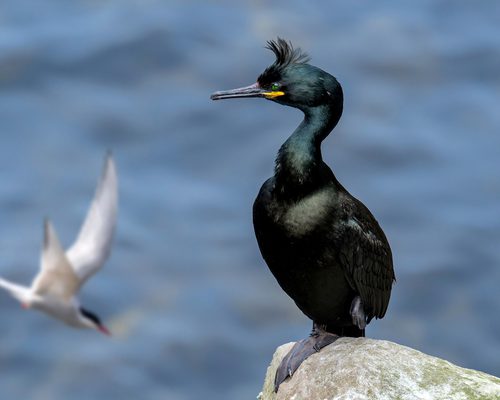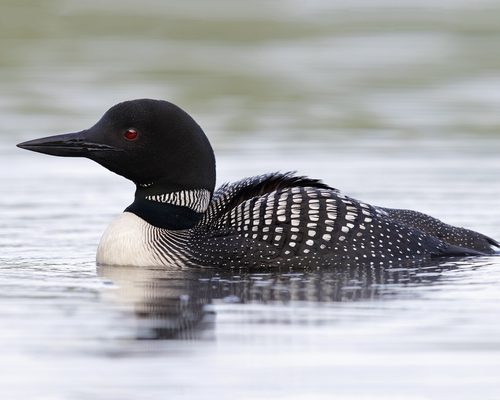Great Cormorant
Least ConcernPhalacrocorax carbo
Visual Identification
Appearance
The Great Cormorant is a large waterbird with predominantly glossy black plumage, often with a greenish or bluish sheen. Adults have a white throat and cheek patch, and during the breeding season, they develop white thigh patches and fine white plumes on the head and neck.
Juveniles are duller brown, with varying amounts of white on the underparts. The bird's distinctive features include its long, hooked bill, bright yellow-orange facial skin, and piercing turquoise-green eyes.
Size
Length
80cm to 100cm
Wingspan
130cm to 160cm
Weight
1.8kg to 3kg
Colours
Males and females have similar plumage
Primary Colour
Black White
Secondary Colour
Brown
Beak Colour
Grey
Leg Colour
Black
Habitat and Distribution
Habitats
Woodland
Garden
Wetland
Coastal
Urban
Farmland
Grassland
Desert
Tundra
Rainforest
Mountain
Savanna
Distribution
Great Cormorants inhabit coastal areas, estuaries, and large inland water bodies across Europe, Asia, Africa, and parts of Australasia. They prefer areas with abundant fish and suitable perching or nesting sites, such as cliffs, islands, or trees near water.
In the UK, they are found along most coastlines and increasingly on inland waters. In North America, they are primarily coastal, with populations along the Atlantic and Pacific coasts.
Elevation Range
Sea level to 1,500 meters
Climate zones
Temperate, Subtropical, Tropical
Distribution Map
This map gives you a rough idea of where you might spot a Great Cormorant. The coloured areas show countries where these birds have been seen.
A few things to keep in mind:
- Birds might not be everywhere in the coloured areas, for example, they may be present around the coast of that country
- Where birds live can change with seasons and available food
- This map is quite simple - it doesn't show exact locations
We're working on making our maps even better! Soon, we hope to show you:
- More detailed maps for bigger countries, including state and region
- How birds move around during different seasons
Distribution by Region
Behaviour and Ecology
Bird Attributes
This feature is in beta. We'd love your feedback to improve it!
Share your thoughtsBird Attributes Explained
Our bird attributes system rates various aspects of a bird's capabilities on a scale of 0-100, based on data from field observations, scientific studies, and expert knowledge.
Attribute Categories:
- Agility: Manoeuvrability, speed, and grace in flight or movement.
- Strength: Physical power, often correlating with size and hunting abilities.
- Adaptability: Ability to thrive in various environments or changing conditions.
- Aggressiveness: Territorial behaviour and assertiveness, particularly during breeding seasons.
- Endurance: Stamina, often seen in migration patterns or foraging behaviours.
Understanding the Ratings:
- 0-20: Very Low
- 21-40: Low
- 41-60: Average
- 61-80: High
- 81-100: Very High
Remember, these attributes are relative to other bird species and don't necessarily indicate superiority.
Hover over the icon next to each attribute for more information.
Tap the icon next to each attribute for more information.
Agility
Reflects the bird's manoeuvrability, speed, and grace in flight or movement.
The Great Cormorant demonstrates remarkable agility in water, capable of diving to depths of 45 metres and manoeuvring swiftly to catch fish. Their ability to propel themselves underwater with powerful webbed feet showcases their aquatic dexterity.
Strength
Indicates the bird's physical power, often correlating with size and hunting abilities.
With a robust build and the capacity to dive deep and catch fish, Great Cormorants exhibit considerable strength. Their ability to carry nesting materials and construct bulky nests further attests to their physical prowess.
Adaptability
Represents the bird's ability to thrive in various environments or changing conditions.
Great Cormorants show high adaptability, thriving in diverse habitats from coastal areas to inland waterways across multiple continents. Their increasing presence in inland waters in the UK demonstrates their ability to adjust to new environments.
Aggressiveness
Measures the bird's territorial behaviour and assertiveness, particularly during breeding seasons.
While not typically aggressive towards humans, Great Cormorants can display territorial behaviour during breeding seasons. Their grunting and hissing sounds during disputes at nesting sites indicate a moderate level of aggression when necessary.
Endurance
Reflects the bird's stamina, often seen in migration patterns or foraging behaviours.
The Great Cormorant's endurance is evident in its long-distance fishing expeditions and its ability to dive repeatedly. Their partial migratory nature and capacity to stay underwater for up to a minute further demonstrate their stamina.
Diet
Great Cormorants primarily feed on fish, including both marine and freshwater species. They are opportunistic feeders, also consuming crustaceans, amphibians, and occasionally small birds.
These birds dive from the surface, pursuing prey underwater and catching it with their hooked bills.
Behaviour
Great Cormorants are excellent swimmers and divers, propelling themselves underwater with powerful webbed feet to catch fish. They are often seen perched on rocks or posts with wings spread, drying their feathers after diving. These birds are generally social, forming large breeding colonies and sometimes fishing in groups.
Vocalisation
Great Cormorants are generally silent away from breeding colonies. At nesting sites, they produce a variety of grunting, groaning, and hissing sounds. The most common call is a deep, guttural 'grock-grock-grock,' often heard during territorial disputes or courtship displays.
Nesting & Breeding
Great Cormorants typically breed in large, noisy colonies, often alongside other seabirds. Pair formation begins in late winter or early spring, with elaborate courtship displays involving wing-waving and gaping.
Nests are bulky structures made of sticks, seaweed, and other plant material, usually built on cliff ledges, in trees, or on the ground on islands. Females lay 3-4 pale blue eggs with a chalky coating.
Both parents incubate the eggs for about 28-31 days and care for the chicks. Young birds fledge after 50-55 days but remain fed by their parents for several weeks after leaving the nest.
Lifespan
years
The Great Cormorant typically lives for 15 to 20 years.
Like all birds, lifespan can be affected by factors including predation, habitat quality, disease, and access to food sources.
Conservation and Status
Global Conservation Status
While the Great Cormorant is listed as Least Concern globally, some local populations face threats from habitat loss and persecution due to perceived competition with fisheries. Conservation efforts focus on protecting breeding sites and managing human-wildlife conflicts in fishing areas.
Birdwatching Tips
- Look for cormorants perched with spread wings on coastal rocks or inland waterways.
- Observe diving behavior - they submerge completely and can stay underwater for up to a minute.
- Listen for their distinctive grunting calls, especially near breeding colonies.
- In the UK, check reservoirs and gravel pits for inland populations.
Additional Information
Quick Facts
Other names:
Black Cormorant, Large Cormorant
Family:
PhalacrocoracidaePredators
Adult Great Cormorants have few natural predators, but eggs and chicks are vulnerable to gulls, crows, and birds of prey. In some areas, foxes and rats may raid ground nests.
Did You Know?
- Great Cormorants can dive to depths of up to 45 meters in pursuit of fish.
- Their feathers are less waterproof than those of other waterbirds, which reduces buoyancy and helps them dive deeper.
- In some Asian countries, cormorants have been trained for centuries to fish for humans in a practice called cormorant fishing.
- There are over 30 species of cormorants across the world, with just two species, the great cormorant and the common shag, resident in the UK.
Was this bird profile helpful?
Your feedback helps us improve our content
Thanks for your feedback!
Your input helps us improve our content.
Community Experience
Community Ratings
No ratings yet - be the first to rate this bird!
Latest Community Reviews
No reviews yet
Sign in to be the first to review
Community Reviews
Create Your Free Account Welcome Back!
Join our community to rate birds and share your experiences. Creating an account is completely free and only takes a minute. Sign in to your account to rate birds and share your experiences with our community.
Your information is secure and will never be shared.
By creating an account, you agree to our Privacy Policy.
FAQs
What is a group of Cormorants called?
The collective nouns to describe a group of cormorants are:
- a flight of cormorants
- a gulp of cormorants
- a “lett fli” of cormorants
- a paddling of cormorants
- a rookery of cormorants
- a swim of cormorants
Similar Birds
References
- 1
website: BirdLife International. 2019. Phalacrocorax carbo (amended version of 2018 assessment). The IUCN Red List of Threatened Species 2019: e.T22696792A155523636.
View source - 2 3
report, 2015: Wetlands International

